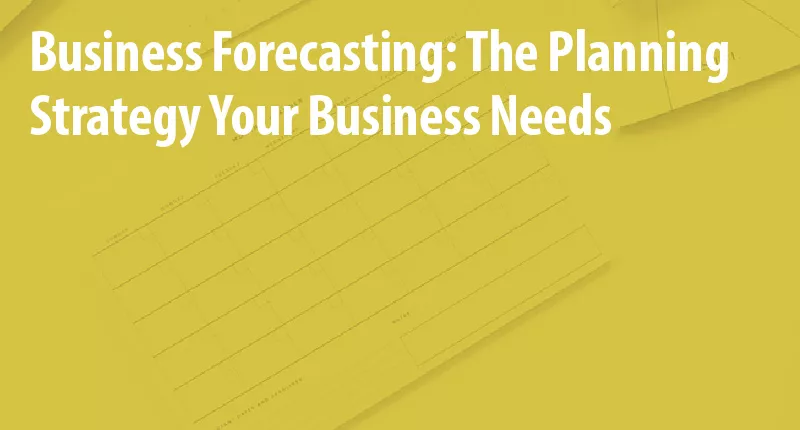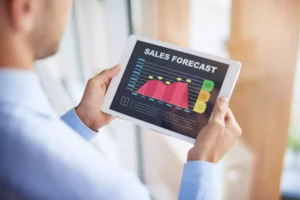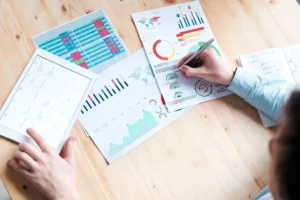
TABLE OF CONTENTS
If you want to secure the continued success of your business, it’s important that you practice business forecasting. Successful organizations have a lot of time and effort invested in predicting future outcomes with reliable data. They use their predictions to create powerful strategies which support long-term visions for growth or survival as they plan out new projects or goals. Since business forecasting is vital to your company’s long-term growth, it’s crucial that you understand it as a business owner. Forecasting in business uses tools and techniques to help business managers and owners more effectively plan their futures. Read on if you’ve ever asked yourself “what is business forecasting?” and are ready to learn how to use the forecasting in business definition to improve your company.

What is Business Forecasting?
Business forecasting is the process of predicting future business developments by analyzing trends in past and present data.
Understanding what business forecasting is and what it can do for your business is integral to creating success. By planning for future events such as expenses, sales, and profits, you can make sound predictions and use resources wisely. Much like the use of a cash flow projection, this also helps you manage unexpected surprises better. The more prepared you are in business, the more likely you are to succeed.
The Types of Forecasting in Business
Even with knowing what forecasting is in business, it is simply not enough to create strategies with. Forecasting has brought success to many organizations. Because of this, various methods have been developed to help managers and business owners make better predictions.
Some methods rely on numerical data, and others on expertise, while others rely more on a gut instinct. Even during times of economic uncertainty, it is important to continue forecasting. Here are three types of forecasting in business to consider.
Qualitative method
Qualitative business forecasting provides a reliable way for managers and owners to predict the future with help from industry experts. This is especially helpful to businesses that don’t have enough historical data available, as well as those looking into new opportunities or markets.
A couple of the most used qualitative models are:
- The Delphi Model: A panel of experts gather and share their opinions on a specific topic. Their predictions remain anonymous and agents collect and use the information to create a forecast.
- Market Research: This is a great way to gather information directly from potential consumers of your product or service by way of a poll or survey. Then, you can use the data to find out when sales would increase or decrease. Don’t know who your target market is?
Quantitative method
In contrast, quantitative business forecasting uses hard numbers like budgets and profits to make predictions about upcoming sales over time. Forecasters do this by looking at current trends. Qualitative methods are typically more expensive than predictive models. However, qualitative services do not require heavy investment from companies that use these types of analyses. Only important factors like expertise can later be reused by other clients if they so desire.
Some of the most popular quantitative models are:
- Economic Modeling: It’s not uncommon for a company that has been in business for a long time to make a major shift. This modeling method uses mathematical equations to test how consistent data is over a long period of time. It also tests the relationship between various data sets. This way, you can plan future shifts ahead of time to reduce any negative effects.
- Trend Analysis Modeling (Time Series Analysis): As the name implies, this method looks at recent and past data to make predictions. It does not include any anomalies or outliers. Instead, it focuses on the most stable data. This happens to be one of the most cost-efficient methods to use.
- Indicator Approach Model: By using the most key leading indicators of business performance, a business can use this data to analyze how lagging indicators will perform in the future.
Casual/average method
In scenarios where the future may resemble what has already happened in the past, the average forecasting method (also called the casual forecasting method) simply takes all of the pertinent historical data and averages it out to come up with a prediction of future outcomes.
How to choose the right forecasting technique
With so many methods to use, how to choose the right forecasting technique can be daunting at first. There are several factors to take into account before making any analysis:
- What will you use the forecast for?
- How much time can you allocate to making a forecast?
- The availability of historical data
- The relevance of any historical data
- What range is acceptable for the accuracy of the forecast
- The value of the forecast to the company
- What period will you analyze and use for the data set?
By laying down the guidelines for what information you will use, you can make more accurate predictions. Many events can happen during an organization’s lifetime (business seasonality, strikes, a shift in business overhead costs, stronger competition), so it is important to take the time to figure out what data to include to make the most accurate forecast possible.
Where Can You Find Data for Business Forecasting?
Unfortunately, forecasting outputs in business are only as good as the inputs used. All data should be relevant and lead to a more accurate prediction of the future. Then, data can be classified into two groups, depending on how the information was acquired.
Primary sources
This type of information is personally gathered by an assigned agent. This individual (or yourself if there is no primary data available) must collect information through the use of questionnaires, interviews, or observations for example. The nature of the data comes directly from the source.
Secondary sources
When you utilize data that has been gathered by others, these are called secondary sources. These sources can include journals, bank financial statements, periodicals, and other organizations. They can also be secondhand accounts from the above sources as well.

Why Business Forecasting Matters in the Long Run
Now that you understand what forecasting is in business and the forecasting business definition, it’s clear that making data-driven decisions can result in a much higher chance of success for a company.
Being able to plan how to react and adapt to changes, possible circumstances, and handle operational changes will result in better management and control and fewer negative impacts. Fortunately, you can always plan for weaknesses and make contingencies. You can also create a business impact analysis and use the data from that report to help with your forecasts.
Forecasting software is widely used as a tool to help make better decisions and plan for the future. Not planning for the future of a company can lead to poor recovery and could force a company to close its doors.
Data is a powerful tool in making more sound and long-lasting decisions. Begin your journey today and begin creating a plan for how to gather information and develop a business forecast. We do not know what the future holds, but with proper preparation, we can develop plans to overcome various circumstances. Don’t risk a business loss, plan for the future and reap the benefits. Make sure to include your business forecasts in your business plan to ensure a bright future.





